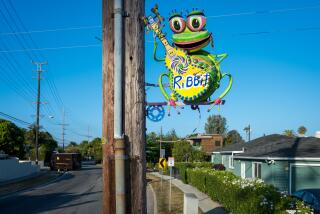Boardwalk: The Debate Continues Over Refurbishment
Mark Ryavec, the executive director of the Venice Boardwalk Assn., seems to be impervious to the truth. On a standing vote, which he himself called for at the meeting sponsored by the Recreation and Parks Department to solicit community sentiment, his plan for refurbishing the Venice Boardwalk was resoundingly rejected. His statement to the press the following day was that there was “no serious opposition to the project.” He now uses your Westside section letters column to blandly throw out the red herring that his opponents “are largely outsiders who do not have the community’s interests at heart.” The name for people who fine-tune the truth like this is, I believe, spin doctor. Mr. Ryavec will not be able to anesthetize us.
RICHARD ABCARIAN
Venice
*
Much ink and breath has already been spent in regard to the proposed Venice Ocean Front Walk Refurbishment Plan. Many believe that all of these meetings, letters and your several articles are part of an exercise to “blow the ink dry” on this proposal that has long been the favorite of L.A. city officials.
Considering the conditions in Venice’s Oakwood district, it seems unthinkable that any plan proposing $650 trash “receptacles” to replace existing “cans” so infrequently emptied, $1,000 benches to replace unrepaired ones stacked within the walls of our derelict ocean-front oil site, and $150,000 restrooms to replace those now standing seat-less and overflowing, could find approval.
The issue here is not the aesthetics of the proposal, but rather its source of funding in present-day Los Angeles. The drawings, diagrams and sketches would be far more appealing if even matching funds were offered by the merchants who pay--and property owners who collect--in the area of $1,000 a yard per month for frontage. If the proposal is approved, (public) monies will go largely to the commercial redevelopment of the Venice oceanfront. Only token consideration is given to repair of the Venice Pier and much needed restroom facilities--both of which also serve commercial interests.
Assertions that this plan concerns itself with preservation and the historical continuity of the community are little more than a ploy. This concourse never was brick-surfaced; the proposed substitutes for “pedestrian scale” street lighting, removed because they were inadequate, will require major repair or replacement of existing security lighting. This proposal, when read in its entirety, not only proposes major redesign, but additionally relocation of the beachfront pagodas. Following this line of “historic” devotion one might anticipate replacement of the Pavilion facilities with a “turn-of-the-century” six-story pink concrete parking structure with gas lights and pull-chain toilets for “authenticity.”
Seriously, the plan proposes demolition of The Venice Pavilion. The structure’s only stay is the fact that all of the available money, and then some, is devoted to the preceding extravagances. Ironically, one reason given for its demolition is lack of parking for the 800-seat theater. Where do the 150,000 daily summer visitors park? For nearly two years Venice Arts Mecca has been negotiating with the city to reopen this facility with corporate donations and at their own succeed-or-fail risk. The cost is comparable to the cost of returning the site to sand.
We will soon know where the city Park and Recreation Department’s sympathies lie--with the commercialists and their “Ocean Front Mall,” or with the community. Surely some more reasonable (and prudent) Venice plan must arise.
SCHELL ALEXANDER
Hawthorne
More to Read
Sign up for Essential California
The most important California stories and recommendations in your inbox every morning.
You may occasionally receive promotional content from the Los Angeles Times.









